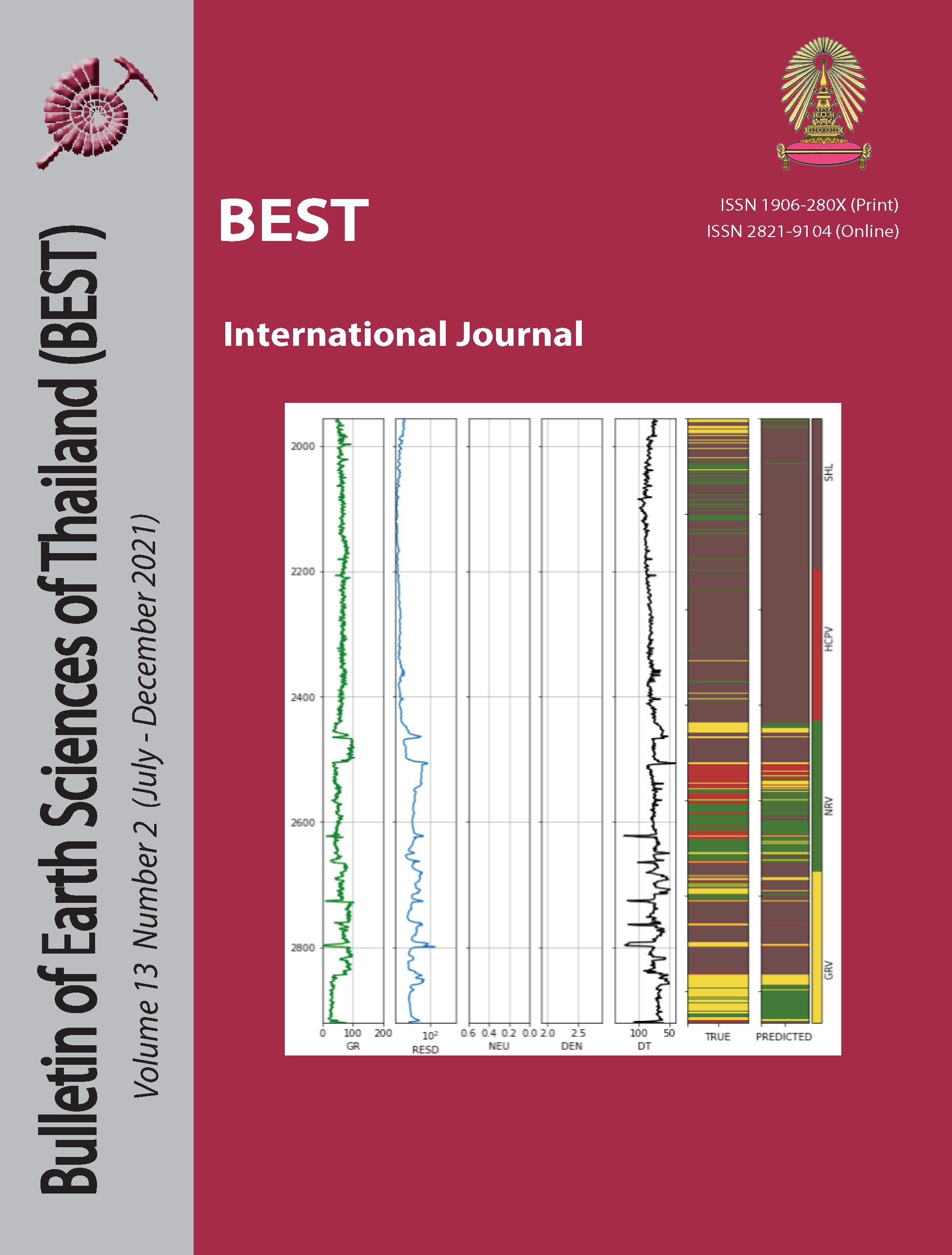Petroleum source rock assessment using outcrop data and geochemical analysis in Phetchabun and Loei Province, Thailand Petroleum source rock assessment using outcrop data and geochemical analysis in Phetchabun and Loei Province, Thailand
Main Article Content
Abstract
The study areas have five locations consisting of Amphoe Lom Sak (ALS), Amphoe Nam Nao (ANN), Grand Canyon Nam Nao (GCNN), Amphoe Mueang Loei (AML) and Amphoe Pak Chom (APC). This study focuses on Huai Hin Lat Formation, Wang Saphung Formation and Nong Dok Bua Formation. Lithology in the study areas consists of calcareous mudstone, argillaceous mudstone, coal-shale, calcilutite, calcarenite and argillaceous shale. A total of eighteen samples for geochemical analysis included quantity, quality, and maturity are useful for identifying and interpreting petroleum source rock and depositional environment. The Total Organic Carbon (TOC) ranges from 0.03 - 20.17 wt.% which is poor to excellent capacity for petroleum potential. Extractable Organic Matter (EOM) ranges are 60 - 4127 ppm (poor-excellent). Type of kerogen is type III (gas prone) and someplace found in type-IV (inert/dry gas) since the components value of Oxygen Index (OI) is higher than Hydrogen Index (HI). Maturity levels of the rock samples in the study area are in immature to over mature stages. The stratigraphic section shows the depositional environment in Amphoe Nam Nao (ANN) and Grand Canyon Nam Nao (GCNN) part of Huai Hin Lat Formation is lacustrine-floodplain or levees and the Amphue Mueang Loei (AML) part of Wang Saphung Formation deposited in foreslope-backreef or lagoon.
Article Details

This work is licensed under a Creative Commons Attribution-NonCommercial-NoDerivatives 4.0 International License.
Copyright © 2008 Department of Geology, Faculty of Science, Chulalongkorn University. Parts of an article can be photocopied or reproduced without prior written permission from the author(s), but due acknowledgments should be stated or cited accordingly.
References
Arsairai, B., Wannakomol, A., Feng, Q., and Chonglakmani, C. (2016). Paleoproductivity and paleoredox condition of the Huai Hin Lat Formation in northeastern Thailand. J. Earth Sci. 27, 350–364. doi: 10.1007/s12583-016- 0666-8.
Bohacs, K. M., Carroll, A. R., Neal, J. E., and Mankiewicz, P. J. (2000). “Lake-basin type, source potential, and hydrocarbon character: an integrated sequence stratigraphic-geochemical framework,” in Lake Basins Through Space and Time, eds E. H. Gierlowski-Kordesch and K. R. Kelts (Tulsa, OK: AAPG).
Booth, J. E., and Sattayarak, N. (2011). “Subsurface carboniferous – cretaceous geology of northeast Thailand,” in The Geology of Thailand, eds M. F. Ridd, A. J. Barber, and M. J. Crow (London: Geological Society of London), 185–222. doi: 10.1144/goth.9.
Booth, J. E. (1998). “The Khorat Plateau of NE Thailand-exploration history and hydrocarbon potential,” in Proceedings of the 1998 SEAPEX Exploration Conference, Singapore, 169–202.
Burrett C., Zaw K., Meffre S., et al. The Configuration of Greater Gondwana-Evidence from LA ICPMS, U-Pb Geochronology of Detrital Zircons from the Palaeozoic and Mesozoic of Southeast Asia and China. Gondwana Research, 2014, 26(1):3151. DOI:10.1016/j.gr.2013.05.020
Chantong, W. 2007. Carbonate reservoir in the Khorat Plateau. in Proceedings of DMF Technical Forum. pp. 55-76.
Charoenpravat, A., Phuanda, J. & Maneenai, D. (1987) Geological map scale 1:50,000 sheets Amphoe Mae Tha (4945-3), Ban Bo Kaeo(4944-1), and Changwat Phrae(5045-3). Geol. Surv. Div., DMR (unpubl., in Thai).
Chonglakmani, C., and Sattayarak, N. (1978). “Straigraphy of the Huai Hin Lat Formation (Upper Triassic) in northeastern Thailand,” in Proceedings on the Third Conference on Geology and Mineral Resources of Southeast Asia, Bangkok, 739–762.
Chuvashov, B., Riding, R. (1984) Principal floras of Palaeozoic marine calcareous algae. Palaeontology. 1984, Vol 27, Num 3, pp 487-500; illustration; ref:3p Coden Pontad, ISSN 0031-0239.
Phujareanchaiwon C, Chenrai P and Laitrakull K (2021) Interpretation and Reconstruction of Depositional Environment and Petroleum Source Rock Using Outcrop Gamma-ray Log Spectrometry From the Huai Hin Lat Formation, Thailand. Front. Earth Sci. 9:638862. doi: 10.3389/feart.2021.638862.
Mouret, C. 1994. Geological history of northeastern Thailand since the Carboniferous. Relations with Indochina and Carboniferous to Early Cenozoic evolution model. Proceedings of the International Symposium on Stratigraphic Correlation of Southeast Asia. Department of Mineral Resources, Bangkok, 245–252.
Racey, A. (2011). “Petroleum geology,” in The Geology of Thailand, eds M. F. Ridd, A. J. Barber, and M. J. Crow (London: Geological Society of London), 351–392.
Ueno, K., Charoentitirat, T., 2011, Carboniferous and Permian. In: Ridd, M. F., Barber, A. J., Crow, M.J. (Eds.), The Geology of Thailand, pp. 71-136-28. The Geological Society of London.


